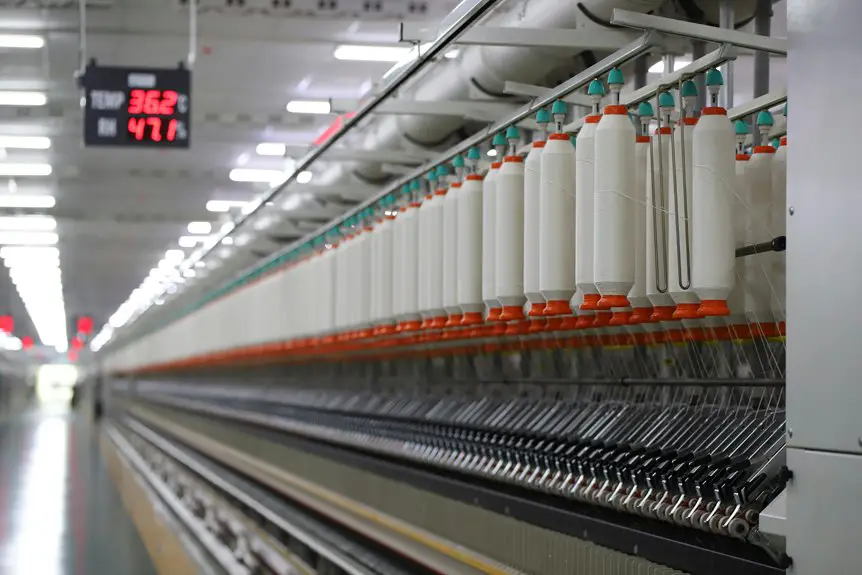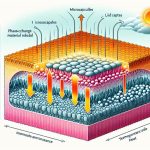Have you ever wished your clothing could adjust to the changing temperatures throughout the day? Advances in fabric technology might just offer the solution you’re looking for. With innovations like phase-change materials and moisture-wicking properties, some fabrics can now respond to heat and sweat. But how do these materials actually work, and what implications do they have for everyday wear? Let’s explore the fascinating world of temperature-adaptive fabrics.
Table of Contents
Key Takeaways
- Temperature-adaptive fabrics incorporate phase-change materials (PCMs) that absorb and release heat for optimal comfort in varying temperatures.
- Moisture-wicking technology in these fabrics helps draw sweat away, promoting cooling during warm conditions.
- Some fabrics are engineered with air pockets to enhance insulation while maintaining breathability for temperature regulation.
- Smart textiles equipped with sensors can adjust their insulation levels based on body temperature changes.
- The market is growing for these innovative fabrics, driven by increased demand for outdoor activities and eco-conscious consumer preferences.
Understanding Temperature-Adaptive Fabrics
As temperatures fluctuate, you might find yourself wishing for clothing that can keep up with your body’s needs.
Temperature-adaptive fabrics are designed to respond to changes in your body temperature and the environment. These innovative materials adjust their properties to either release heat or retain warmth, ensuring you stay comfortable regardless of the weather outside.
For instance, some fabrics incorporate phase-change materials that absorb excess heat when you’re warm and release it when you cool down. Others use moisture-wicking technology to draw sweat away, helping you stay dry and cool.
Mechanisms Behind Fabric Thermoregulation
While you may not realize it, the mechanisms behind fabric thermoregulation play an essential role in your comfort. These fabrics use various strategies to manage heat and moisture.
For instance, phase change materials (PCMs) absorb, store, and release heat as temperatures fluctuate. When you’re warm, they absorb excess heat; when it cools down, they release it back to your body.
Additionally, moisture-wicking fibers draw sweat away from your skin, promoting evaporation and cooling. Some fabrics incorporate air pockets, enhancing insulation while allowing breathability.
Innovations in Advanced Materials
With the constant evolution of technology, innovations in advanced materials are reshaping how you experience clothing and textiles. You’ll find fabrics that respond to temperature changes, keeping you comfortable in various conditions.
Smart textiles, embedded with sensors and actuators, can adjust insulation levels based on your body heat and external climate. For instance, phase change materials absorb, store, and release heat, allowing you to stay warm or cool as needed.
Smart textiles adapt to your body heat and climate, ensuring optimal comfort with innovative phase change materials.
Additionally, self-cleaning fabrics use nanotechnology to repel dirt and moisture, enhancing durability and convenience. These advancements not only improve comfort but also open up new possibilities for fashion and functionality, making your wardrobe more versatile than ever before.
Embrace these changes; your everyday attire is about to get smarter!
Energy Efficiency and Challenges in Fabric Technology
As you explore the world of adaptive fabrics, you’ll notice the pressing concerns around energy consumption.
Balancing innovative technology with sustainable production methods presents unique challenges.
It’s essential to reflect on how these fabrics can be both efficient and environmentally friendly.
Energy Consumption Concerns
Although innovative fabrics promise enhanced thermal regulation, energy consumption concerns loom large in the development of these technologies.
You might be excited about the potential of smart fabrics, but it’s crucial to evaluate the energy costs associated with their production and use. Many of these fabrics rely on embedded technologies, which can increase their energy footprint.
As you weigh the benefits of comfort and adaptability, think about how these fabrics might contribute to overall energy consumption in your daily life.
Manufacturers face challenges in creating energy-efficient solutions that minimize environmental impact while still delivering performance.
Ultimately, balancing functionality with sustainability is key, and it’s up to consumers like you to demand eco-friendly options as you explore the future of fabric technology.
Autonomous System Challenges
While the potential of autonomous systems in fabric technology is exciting, significant challenges remain in achieving energy efficiency. You’ll find that integrating smart materials requires advanced sensors and algorithms, which can consume considerable energy. Additionally, the complexity of these systems may lead to maintenance issues, further complicating energy management.
Here’s a quick overview of the challenges:
| Challenge | Description | Impact on Efficiency |
|---|---|---|
| High Energy Consumption | Sensors and algorithms require power | Reduces sustainability |
| Complexity of Systems | Maintenance demands increase energy use | Hinders overall efficiency |
| Material Limitations | Current fabrics may not support tech | Limits adaptability |
Addressing these challenges is essential for creating fabrics that truly adapt to changing temperatures efficiently.
Sustainable Production Methods
To create fabrics that adapt to changing temperatures sustainably, manufacturers must embrace innovative production methods that prioritize energy efficiency.
You’ll find that energy-efficient technologies, like solar-powered machinery and waste-reducing techniques, considerably lower the carbon footprint of fabric production. By utilizing renewable resources and recycling materials, you can also minimize waste and conserve energy.
However, challenges remain, such as the need for substantial upfront investments and the integration of new technology into existing systems. It’s essential to balance these challenges with the long-term benefits of sustainable fabrics.
As you explore this evolving industry, keep an eye on companies committed to sustainable practices, as they pave the way for a greener future in fabric technology.
Current Market Trends and Industry Growth
As consumers increasingly seek comfort and versatility in their clothing, the market for temperature-adaptive fabrics is experiencing significant growth. You’ll notice brands incorporating innovative materials that respond to varying temperatures, enhancing your wearing experience.
This trend is driven by a rise in outdoor activities and a shift towards athleisure styles, where functionality meets fashion.
Moreover, sustainability plays an essential role; eco-conscious consumers prefer fabrics that not only perform well but are also produced responsibly. Companies are investing heavily in research and development, aiming to create smarter textiles that can regulate body temperature.
As awareness of these benefits spreads, you can expect more retailers to offer these adaptive solutions, making temperature-regulating fabrics a staple in modern wardrobes.
Future Developments in Temperature-Regulating Fabrics
As you explore the future of temperature-regulating fabrics, you’ll notice exciting innovations on the horizon.
AI integration could revolutionize how these materials respond to your body’s needs, while sustainable materials promise to make them more eco-friendly.
Together, these advancements could transform your wardrobe into a smarter, more adaptable solution for changing climates.
AI Integration in Fabrics
Although traditional fabrics have laid the groundwork for temperature regulation, the integration of AI is poised to revolutionize how these materials respond to environmental changes.
Imagine wearing a fabric that learns your body’s temperature preferences and adjusts accordingly. With AI algorithms, fabrics can analyze real-time data like humidity and external temperature, optimizing insulation and breathability. This means you’ll stay comfortable whether it’s hot or cold outside.
Smart textiles can even communicate with wearable tech, providing feedback to enhance your experience. As AI continues to evolve, these adaptive fabrics could become more personalized, offering you a unique blend of comfort and functionality.
Embracing this technology could redefine your wardrobe, making it smarter and more responsive to your lifestyle.
Sustainable Material Innovations
While the future of temperature-regulating fabrics looks promising, sustainable material innovations are taking center stage.
You’ll find that many researchers are now focusing on eco-friendly fibers like organic cotton, recycled polyester, and even innovative biopolymers. These materials not only reduce environmental impact but also provide excellent breathability and moisture-wicking properties, enhancing comfort in changing climates.
Some brands are experimenting with natural dyes and treatments, ensuring that the manufacturing process aligns with sustainability goals.
As a consumer, you can look forward to fabrics that not only adapt to your body’s needs but also contribute positively to the planet. Embracing these advancements means you’re choosing both comfort and environmental responsibility in your wardrobe.
Potential Applications in Various Sectors
Fabrics that adapt to changing temperatures are set to revolutionize multiple sectors, enhancing comfort and functionality in everyday life.
Imagine wearing clothes that keep you cool in the heat and warm when it’s chilly. These innovative materials can transform industries by:
Experience the future of clothing with fabrics that adapt to temperature, ensuring comfort in any season.
- Fashion: Designers can create garments that react to temperature fluctuations, offering year-round versatility and comfort for consumers.
- Sports: Athletes can benefit from performance wear that adjusts to their body temperature, improving endurance and comfort during intense activities.
- Healthcare: Patients in hospitals could wear smart textiles that regulate body temperature, enhancing recovery and overall well-being.
As these adaptive fabrics gain traction, you’ll find yourself experiencing a new level of comfort across various aspects of your life.
Frequently Asked Questions
How Do Temperature-Adaptive Fabrics Feel Against the Skin?
Temperature-adaptive fabrics feel incredibly comfortable against your skin. They regulate warmth, keeping you cool when it’s hot and cozy when it’s cold. You’ll notice a smooth, lightweight sensation, enhancing your overall wearing experience.
Can These Fabrics Be Washed and Dried Normally?
Yes, you can wash and dry these fabrics normally. Just follow the care instructions provided. They’re designed to withstand regular laundry routines, so you won’t need to worry about special treatment or damage during cleaning.
Are Temperature-Regulating Fabrics Suitable for All Climates?
Temperature-regulating fabrics can be great in various climates, but their effectiveness may vary. In extreme conditions, they might not perform as well. You should consider your specific climate needs when choosing these fabrics for best comfort.
How Long Do These Fabrics Last Before Losing Effectiveness?
You might wonder how long these innovative fabrics stay effective. Typically, they maintain their properties for several years, but factors like wear and washing can shorten their lifespan. Regular care helps extend their performance, though.
What Is the Cost Range for Temperature-Adaptive Clothing?
You’ll find temperature-adaptive clothing typically ranges from $50 to $300, depending on the brand and technology used. Higher-quality options often offer better performance, so consider investing for long-lasting comfort and functionality in varying climates.
- Best Pillow and Bedding Fabrics for Hot Sleepers - June 8, 2025
- What Are the Quietest Fabrics for Hunting in Various Weather? - June 8, 2025
- How to Layer Wool Effectively for Maximum Cold Weather Comfort - June 8, 2025







